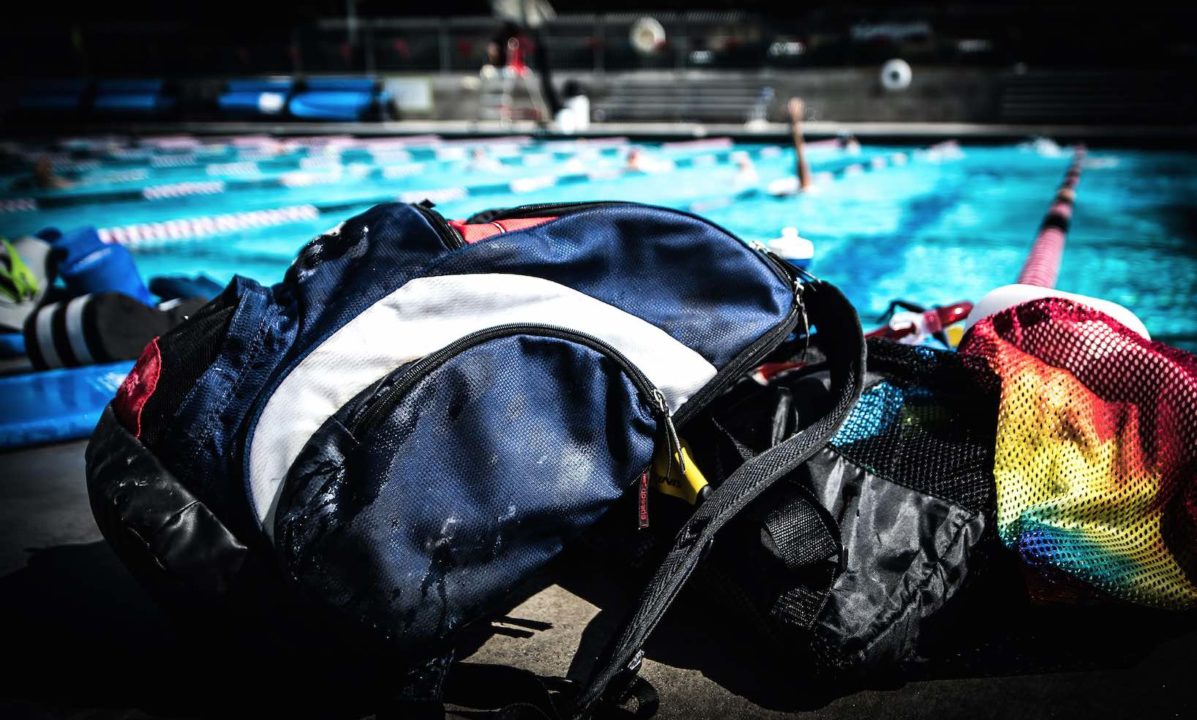With the world shutting down, we’re reaching into our archives and pulling some of our favorite stories from the SwimSwam print edition to share online. If you’d like to read more of this kind of story, you can subscribe to get a print (and digital) version of SwimSwam Magazine here. This story was originally published in the 2017 Year In Review edition of SwimSwam Magazine.
Story by Daniel L. Carl, Ph.D.
We have all left a wet towel in our swim bag overnight or for a couple of days only to open the bag to a rather pungent smell. That’s easy to fix: Simply remove the towel to the wash and let the bag air out, and all is well in a short time.
But what happens when that damp, musty smell remains in your swim bag and doesn’t go away? That’s most likely indicative of mold or mildew. When this occurs, a direct and definitive course of action is required, or the mold source will continue to make its presence known again and again.
So how do you know if it’s mildew or mold, and does that make a difference?
Mildew is a type of mold characterized by its powdery look and flat growth on the surface of your bag. Because it’s on the surface and does not necessarily penetrate the fabric, it is easier to wipe away. Mold, on the other hand, has black or green patches that penetrate beneath the surface of the affected material. As a result, it’s more difficult to remove.
Regardless of the type of mold, breathing in mold spores may negatively affect your health. Common symptoms include reactions similar to an allergy, including sneezing, throat irritation, nasal congestion, itching or rash from direct contact, and watery, sore eyes. People with asthma may experience exacerbated symptoms. All concerns should be addressed with your physician.
So how can you prevent mold from growing and your swim bag from smelling?
First, identify the causes of the mold development and remove them as much as possible. The primary culprit is moisture, so removing your wet or damp towels and your swim cap immediately after practice is foremost. Left in the bag, they harbor mold growth.
Dry clothes should also be removed. Though it’s easy to throw your shorts, shirt, and socks back in the bag for your next practice and think nothing of it, these items contain moisture from sweat and should not be left in your bag for extended periods, as mold growth can begin to take hold in as little as one day.
Also remove any paper products from your bag — including newsletters, handouts, homework, and food wrappers — that may sit at the bottom and retain moisture and potentially mold spores.
Finally, the humidity of the room in which you store your bag is often overlooked. High humidity inside your home can accelerate mold growth, so you need a well-ventilated area with 50% or less humidity to hang your towels, cap, and clothes.
So how do we remove the mold if it has already taken hold? The only way to control the smell is to remove the mold completely. Air fresheners and disinfectant sprays may temporarily cover up the smell, but they won’t remove the mold, and its reappearance is almost guaranteed. Mold prefers the dark, and the inside of your bag along the creases and corners provides the perfect environment to grow.
Prevention is key — once a week, clean your bag thoroughly with a disinfectant wipe, and, making sure the compartments are unzipped, leave the bag in a well-lit and well-ventilated area.
If mold is already present, you have a few options to consider:
- Turn your bag inside out and wash it in your washing machine. A mild soap, warm water, and a gentle cycle should be sufficient to remove stains, dirt, and some mild buildup.
- Consider hand-washing with a bleach cleaner, being careful to watch and test for color-fading issues.
- Hand-wash with a solution of one part vinegar to two parts warm water, again testing for color issues, before an all-out cleaning.
Keep in mind that there are as many mold-removal techniques.
While no one wants to part with their favorite swim bag, if mold continues to return — and potentially harm your health — it may be time to search for that new perfect bag.
About Daniel L. Carl, Ph.D.
Dan Carl is an Associate Professor of Exercise Physiology in the Department of Rehabilitation, Exercise and Nutrition Sciences at the University of Cincinnati. Dr. Carl also works as a Senior Coach and consultant with the Cincinnati Marlins and as head coach at Sycamore HS. Prior to his 13 years in Cincinnati, Dr. Carl worked 14 years as a Division I coach at Miami Univ., Univ. of Delaware, Ohio State Univ. and Valparaiso University.

I understand the frustration of dealing with a smelly swim bag. The combination of chlorine, dampness, and bacteria can create quite an unpleasant odor. Fortunately, there are several steps you can take to address this issue and keep your swim bag fresh.
- Dry your gear: After each swim session, make sure to thoroughly dry your swimsuit, towel, and any other wet items before placing them back in your bag. Moisture is a breeding ground for bacteria, which can contribute to the unpleasant smell.
- Wash your swim gear regularly: It’s essential to clean your swim gear regularly to remove chlorine and bacteria buildup. Rinse your swimsuit, goggles, and caps with fresh water after each use, and consider washing them with
… Read more »Thanks for sharing informative article, I really like this post.
A nice relief from, ahem, current events. Thanks for the laugh!
My swim bag smells like a combination of stale chlorine, old potato chips and bubblegum…I LOVE It!!!
Our kids bag smell from dryland clothes and uneaten lunches
🤮